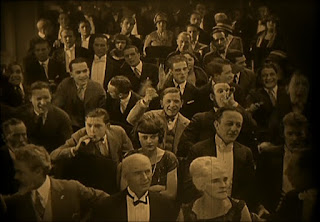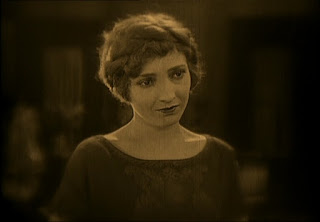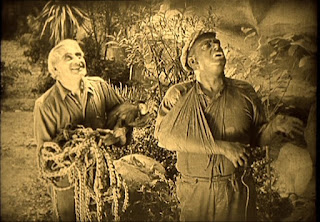There is so much to savour in the work of Victor Sjöström, Lars Hanson and Lillian Gish... this being my third go with The Wind, new responses occur with each viewing, especially in different contexts here at the BFI with Stephen Horne’s uncanny ear for emotional narrative.
Of the films I’ve seen from Sjöström’s Hollywood period, The Wind is the one that most reflects the
landscape cinema of his homeland, allowing him to add the character and context
of the environment. In this story, the elements are as much a player as the
actors, especially the protean, elemental Lillian Gish… No actor can ever have
been so moved by unbending force or swirled as helplessly by the
combined brute forces of male desire and dust storm.
This is the film in which Lil really lets her hair down
and is one of her most sexually expressive performances: Lige Hightower’s gasp
when he sees Letty, hair down, button undone in their bedroom is felt by the
audience too. Gish was 35 and even though her character starts out intimidated
by her new environment she’s quick to use her allure with well-heeled Wirt
Roddy (Montagu Love) when he comes to her rescue on the train. By the same
token she’s very dismissive of the attentions of Lige (Lars Hanson) and his
comic side-kick Sourdough (William Orlamond) – she knows what’s she’s worth.
 |
| Lillian lets her hair down |
We never learn much about the reasons for her exile to stay
with her step-brother Beverly (Edward Earle) in these unfriendly outlands but
the instant dislike of his wife Cora (Dorothy Cumming) may suggest some history?
Then again, to Cora, this eastern softie is just another mouth to feed, of
little use and there’s a telling scene in which she is busy disembowelling a cow,
up to her elbows in blood, whilst Letty stops ironing to play with their children - Cora
multi-tasks, towering over Letty with bloodied hands next to the carcass that will feed the family
for weeks. Then Bev arrives and Cora puts those hands over his shoulders and gives him a full-blooded kiss only for him to be distracted by his pretty "sister"...
 |
| Not a cow. |
Cora understandably hopes to marry Letty off as soon as she can and the
latter is keen enough on what she assumes to be a rich bachelor but when Wirt
reveals that he is married and wants merely wants to “keep” her… that’s too much.
Letty marries Lige because he’s her only option but she
can’t bring herself to consummate their relationship. By this stage Lars Hanson
has started shaving and only a mad woman could ignore his scandi charms
especially when he pledges not to bother his bride and to save up to send her
back. His physical performance is on a par with Gish as he transforms from a
clumsy, loutish cowhand to a man of dignity and leadership.
 |
| Love quadrangle? |
Everyone is changed by the wind. Beverley and Cora have
already learned how to survive whilst Wirt tries to rise above it, constantly
brushing the sand from his clothes with the knowledge that someone else will do
his dirty work. He tells Letty that the wind will have its moment with her and
so it does.
Whilst Mordaunt Hall, film critic for The New York Times, may have fussed that
the elemental motifs were overplayed but most of us find that Sjostrom’s
treatment has stood the test of time. From the opening shots of the wind scudding
across the plains as Letty’s train makes its way, to her dust-drenched arrival,
white wide-brimmed hat blowing down on her face as Victor’s aero-engines did
their worst, the wind is ever present. Letty has headed straight into the heart
of the storm and faces the biggest test of her life.
 |
| Man with the lamp - Lars Hanson |
As she eats with Bev’s family the sand encrusts the food
and even as Wirt wins her away from Lige at the town dance a cyclone drives
them into the storm shelter as the men shore up doors and walls. Living with
Lige the “Norther” approaches, the mightiest wind, and plans are made to
protect life and livestock before it is too late. The Norther – a satanic
elemental force – is represented by a ghostly white stallion but the horse also
has a Lawrencian interpretation…
Wirt is also unstoppable and abandons the men’s emergency
cattle drive by faking exhaustion and engineering a recuperative stay alone
with Letty: the Norther wind, Wirt and judgement have all arrived at the same
time and now Letty must find a way to survive the storm.
Stephen Horne delivered a masterclass in supportive narrative
with a sympathetic symphony that incorporated the sinister “breath” of accordion
to piano string-thwacking musique concrète
for the havoc of the storm. To perform an emotional duet with Lillian Gish you
need to match her expressive agility and Stephen has clearly been here before as
he mirrored her razor-sharp shifts in tonal response to the repeated
interjections of the wind, man and sand. This film drives on ever harder but
not in a linear way and Mr Horne kept his ferocity in check until it was time
to let the horses loose! They might need to re-tune the BFI’s upright after
this Norther…
 |
| Blisters on her fingers... Gish burned her hand on desert-scorched door handle. |
Gish chose this film for her strengths and she also
picked Victor Sjöström and Lars Hanson for theirs - she’d been impressed by Lars’
Gosta Berling… now there’s a film we
haven’t seen on screen, London!). Hanson matches her stride for
stride and follows a similar trajectory from self-indulgence to self-sacrifice
whilst finally Victor could explore the great outdoors, filming in style in the
120 degrees of the Mojave Desert: a physical and emotional challenge for cast
and crew; they even had to freeze the film to prevent the emulsion melting.
They may have changed the original ending – after which
Victor told them they could keep their "Seastrom" and headed back to Sweden – but
the result resonates full-force ninety years later.















































%20oleading.png)



%20Despair.png)

%20breakdown.png)



